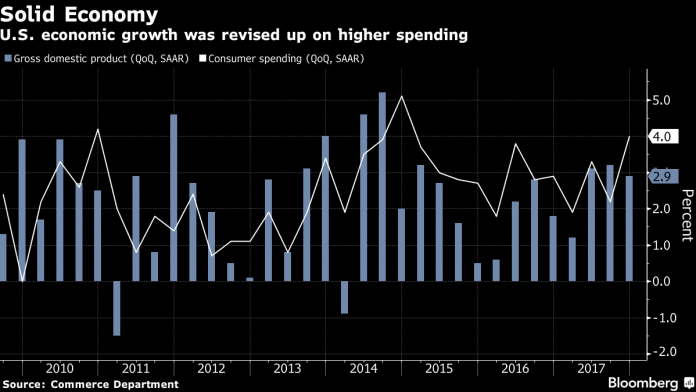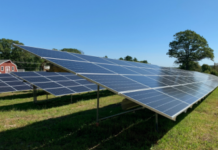
NEW YORK – The U.S. economy grew in the fourth quarter at a faster pace than last estimated, helped by an upward revision to household spending on services and a smaller drag from inventories, according to Commerce Department data released Wednesday.
Highlights of fourth-quarter GDP (Third estimate)
- Gross domestic product grew at a 2.9 percent annualized rate, (est. 2.7 percent) revised from 2.5 percent
- Consumer spending, biggest part of the economy, grew 4 percent (est. 3.8 percent) revised from 3.8 percent
- Before-tax corporate pretax profits rose 2.7 percent year over year in the first estimate issued for the fourth quarter; climbed 5.3 percent in third quarter
- Inventories subtracted 0.53 percentage point from GDP growth, compared with prior estimate of 0.7 percentage point drag
- Nonresidential fixed investment rose 6.8 percent, revised from 6.6 percent gain and reflecting a 6.3 percent jump in outlays for structures (prev. est. 2.5 percent)
- Gross domestic income, adjusted for inflation, rose 0.9 percent following 2.4 percent gain in third quarter
Key takeaways
The revisions to GDP, the value of all goods and services produced in the U.S., indicate the economy was on a solid footing coming into the current quarter.
The report also included the first look at the health of corporate America toward the end of 2017. The gain in fourth- quarter profits from a year earlier, together with lower corporate taxes following the tax overhaul signed by President Donald Trump late last year, bodes well for business investment and employment.
Household purchases, which account for about 70 percent of the economy, also are likely to be supported in coming months by bigger after-tax paychecks and the robust labor market. Continued gains in consumer spending and business investment will help to sustain the expansion even as GDP growth is projected to cool somewhat in the first quarter.
The Federal Reserve Bank of Atlanta’s GDPNow tracking estimate for the current quarter was at 1.8 percent as of March 23. The median forecast in a Bloomberg survey of economists showed a 2.5 percent pace. While the survey shows consumer spending slowing to a 2.1 percent rate, Fed officials remain upbeat about the prospects for households.
Policy makers this month boosted their median forecast for economic growth this year to 2.7 percent from 2.5 percent at their December meeting. The expansion, now in its ninth year, is poised to become the second-longest on record later in 2018.
Price data in the GDP report showed inflation is hovering near the Fed’s 2 percent goal. Excluding food and energy, the central banks’s preferred price index that is tied to personal spending rose at an unrevised 1.9 percent annualized rate.
Other details
- Pre-tax corporate profits fell 0.1 percent from prior quarter after 4.3 percent third-quarter increase; reflects decline in earnings at financial firms
- Upward revision to consumer spending on services was primarily related to transportation, government says
- Net exports subtracted 1.16 percentage points from GDP growth, revised from 1.13-point drag
- Business spending on equipment rose 11.6 percent after previously reported 11.8 percent
- Residential investment grew at a 12.8 percent rate, revised from 13 percent
- Real final sales to domestic purchasers, which strip out trade and inventories – the two most volatile components of the GDP calculation – advanced 4.5 percent, revised from 4.3 percent
- Government spending increased at a 3 percent rate, revised from a 2.9 percent gain on higher state and local outlays GDP report is the third of three estimates for the quarter
Shobhana Chandra is a reporter for Bloomberg News.












